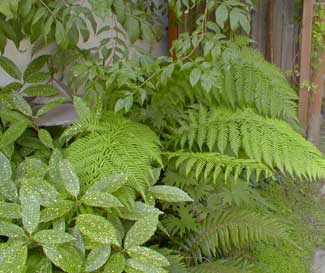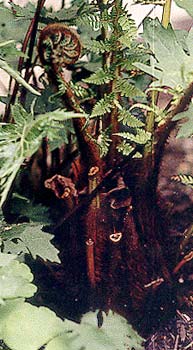
Raising a baby Tasmanian Tree Fern on Puget Sound
The Tasmanian Tree Fern (Dicksonia antarctica) is the most cold hardy of the giant tree ferns. Still, despite the species name "antarctica" — derived from the fact that the family as a whole lives around the lower half of the globe — it really can't stand freezing temperatures.
It can be killed at 15 to 17 degrees Fahrenheit; 20 degrees is about it for safe low tolerance, & it's safe only then if it won't be that cold very often or very long. In our hilltop neighborhood we can go several years running without the worst days being below 20, but when there is a genuine cold-snap, it can last several days or a couple weeks, & that could be enough time to kill a tree fern. So they're not inevitably suited to Puget Sound weather, though with some some attention they often do adapt.
So it was only a little against the probability of success when we began growing one of these beauties. Despite the risk, we knew that old specimens have been grown outdoors in Scotland & along the coast of Oregon all the way up to British Columbia, usually in sheltered outdoor gardens but sometimes unprotected. A local display garden (at Heronswood nursery) has a handfull of them full grown underneath Douglas fir trees. To get them through winters, they tie up the fronds & wrap the trunks in black plastic or garden cloth.
The provenance of each specimen has a lot to do with its success in places like Seattle or Victoria, B.C. Alas, it is pretty hard to know their exact provenance, so one can only try one & either succeed or fail. In years to come there will undoubtedly be increasingly cold-hardy offerings specifically from high-mountain areas or chillier far-south islands, & success with them in the Pacific Northwest will become more certain.
Here's what we've done to increase our chances of not ending up sad the next time we have a relatively nasty winter. First of all we chose a location in the yard that is deeply shaded, as a tree fern doesn't like much sun. This corner of our shade-garden is enclosed on three sides: the house to the back, a six foot fence to the side, & an akebia arbor connecting to a garage wall on the the third side.
 Into this concavity went the Tasmanian tree fern, not too distant from the window of a heated basement. The window is not thermopane, so there is heat-loss through it. My expectation is that when we have occasional cold spells, this sheltered corner in front of a warm window will protect the tree fern even without my having to cover it up, though if there's an extended cold spell I'll take additional measures to wrap the bottom in paper.
Into this concavity went the Tasmanian tree fern, not too distant from the window of a heated basement. The window is not thermopane, so there is heat-loss through it. My expectation is that when we have occasional cold spells, this sheltered corner in front of a warm window will protect the tree fern even without my having to cover it up, though if there's an extended cold spell I'll take additional measures to wrap the bottom in paper.Its first winter turned out to have many twenty degree days that lasted later into the new year than is usual, so it really got tested. What fronds did not die back from the cold looked so pitiful in spring that I had to cut off what remained. In earliest May it produced lovely huge croziers. The photo at right shows the first of the croziers to erupt in spring, a couple weeks after I clipped off the last of the winter-damaged fronds from the previous year. Then, by the end of May, it had freshened itself up with gorgeous sweeping fronds of awesome beauty.
During its second winter temperatures were milder, & the tree fern made it through without even a slight hint of frost damage, so it seemed to be hardening up nicely.
So it looked as though "at worst" our purportedly evergreen Tasmanian tree fern will not through unusually cold winters prove to be evergreen, but in this worst-case possibility will behave deciduously, & otherwise thrive. Each year it lives will mean it has become increasingly adapted. And when I saw a photograph of a healthy tree fern under a hard snowfall, I figured ours will never suffer worse than that.
Ours is still a youngster & looks like a giant fern with only a foot-tall nubby hump of a trunk starting. These are slow-growing & long-lived trees, so ours will have a nub instead of a trunk for some while to come. But over time it should bulk upward (potentially to fifteen feet) so that the giant fronds will someday be overhead.